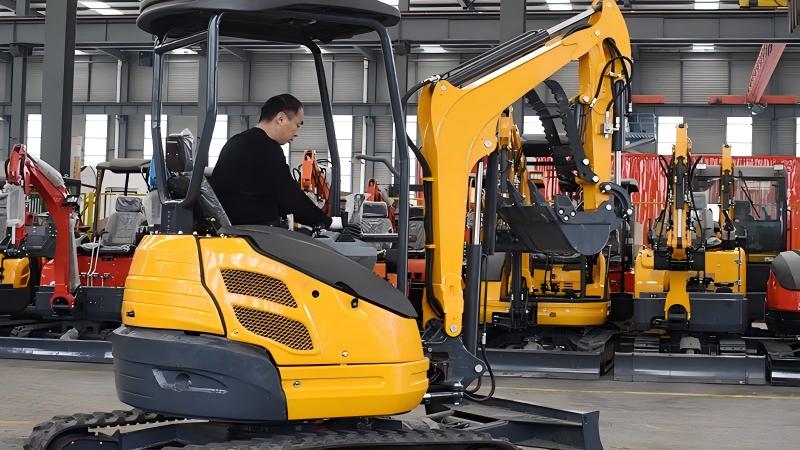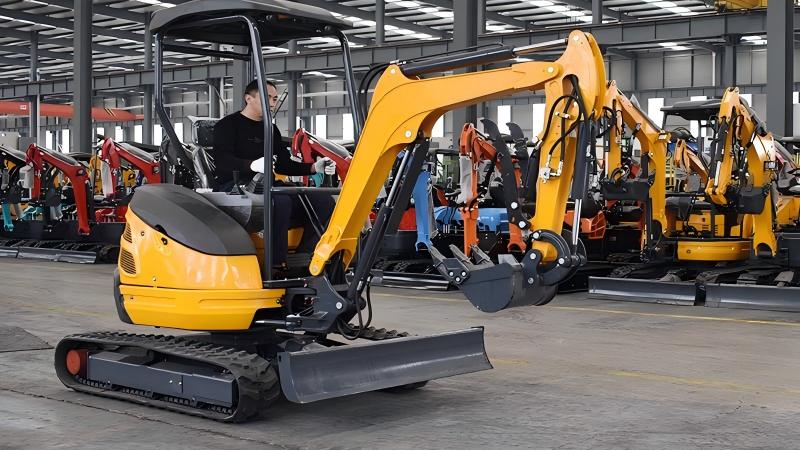Mini excavators have become indispensable tools across various industries, from landscaping and construction to utility work and DIY projects. Their compact size, versatility, and ability to navigate tight spaces make them an attractive option for a wide range of tasks that would be far too laborious or impossible with manual labor. Given their growing popularity, a common question arises for those new to heavy equipment: "Are mini excavators easy to operate for beginners?"
The short answer is: relatively, yes, but with important caveats. While mini excavators are generally considered more user-friendly than their larger counterparts, mastering their operation requires a combination of understanding the controls, adhering to safety protocols, and gaining practical experience. This article will delve into the factors that contribute to their accessibility for novices, highlight the challenges a beginner might face, and offer advice on how to approach learning to operate one safely and effectively.
Why Mini Excavators Are Considered Beginner-Friendly
Several design and functional aspects contribute to the perceived ease of use for mini excavators:
Intuitive Controls: Most modern mini excavators employ hydraulic joystick controls, which are generally intuitive once you understand the basic movements. Typically, one joystick controls the boom and bucket, while the other controls the stick (dipper arm) and swing. Foot pedals usually operate the tracks for forward, reverse, and turning. While the initial coordination can feel like rubbing your belly and patting your head, the logic behind the movements often clicks relatively quickly.
Proportional Control: Many mini excavators feature proportional hydraulic controls, meaning the speed and force of the attachment movements are directly proportional to how far you push the joysticks. This allows for precise, subtle movements, which is crucial for delicate tasks and reduces the likelihood of abrupt, uncontrolled actions.
Compact Size and Maneuverability: Their smaller footprint makes mini excavators less intimidating than full-sized excavators. They are easier to navigate in confined spaces, reducing the risk of accidental collisions. The ability to swing the boom independently of the tracks (zero tail swing or reduced tail swing models) further enhances their maneuverability in tight quarters, making them less prone to hitting obstacles behind them.
Lower Power and Speed: Compared to larger excavators, mini excavators have less raw power and operate at slower speeds. This inherently makes them more forgiving for beginners, as mistakes are less likely to result in catastrophic damage or injury. The slower pace allows more time for reaction and correction.
Visibility: Most mini excavators offer excellent visibility from the operator's cab, allowing the operator to clearly see the bucket, the tracks, and the surrounding work area. This enhanced visibility contributes significantly to confidence and safety for beginners.
Safety Features: Modern mini excavators are equipped with numerous safety features, such as roll-over protective structures (ROPS) and falling object protective structures (FOPS), seatbelts, safety levers that disable controls when the operator leaves the seat, and backup alarms. These features provide a safety net that can be particularly reassuring for new operators.
Challenges and Considerations for Beginners
Despite their beginner-friendly attributes, operating a mini excavator is still a complex skill that comes with its own set of challenges:
Hand-Foot Coordination: The simultaneous coordination of joysticks and foot pedals can be challenging initially. Beginners often struggle with independent movement of the boom, stick, bucket, and swing while also managing the tracks. Practice is key to developing this muscle memory.
Spatial Awareness and Depth Perception: Accurately judging distances, depths, and angles, especially when digging or grading, takes time and practice. Misjudging depth can lead to inefficient digging or, worse, striking underground utilities.
Understanding Ground Conditions: A beginner might underestimate the impact of different soil types, slopes, and ground stability on the machine's performance and safety. Operating on uneven or soft ground requires careful technique to prevent tipping or getting stuck.
Learning Attachments: While the basic digging motion is relatively consistent, operating various attachments (e.g., augers, hydraulic breakers, grapples) requires understanding their specific functions and how they interact with the machine's hydraulics. Each attachment adds a layer of complexity.
Safety Protocols and Hazards: Operating any heavy machinery carries inherent risks. Beginners must be acutely aware of potential hazards, such as overhead power lines, underground utilities, unstable ground, and the swing radius of the machine. Neglecting safety protocols can lead to serious accidents.
Machine Limitations: Beginners might push the machine beyond its capabilities, leading to stalls, tip-overs, or damage. Understanding the mini excavator's lifting capacity, digging depth, and reach is crucial.
Maintenance and Pre-Operation Checks: While not directly related to operating, understanding daily maintenance checks (fluids, tracks, pins) and pre-operation inspections is vital for safe and reliable performance, and beginners need to learn these routines.
Tips for Beginners Learning to Operate a Mini Excavator
For those venturing into mini excavator operation, here are some actionable tips:
Read the Operator's Manual: This is non-negotiable. The manual provides specific information on controls, safety procedures, maintenance, and the machine's capabilities unique to that model.
Start with Basic Movements: Before attempting complex tasks, spend time in an open, flat area practicing individual movements:
Driving forward and backward in a straight line.
Turning the machine with the tracks.
Swinging the boom left and right.
Extending and retracting the stick.
Curling and dumping the bucket.
Practice Smooth, Coordinated Movements: Once comfortable with individual controls, try combining them slowly. The goal is to make fluid, efficient motions, not jerky, sudden ones. Imagine painting with the bucket rather than scratching.
Understand the "Thumb Rule": Many operators simplify joystick movements by thinking about their thumb on the joystick. Pushing forward/back on the right joystick moves the boom up/down. Pushing forward/back on the left joystick moves the stick in/out. This can vary based on control patterns (e.g., ISO vs. SAE), so always check.
Start Small and Simple: Begin with easy tasks like scraping loose dirt, moving a small pile of material, or digging a shallow trench in soft ground. Gradually work your way up to more complex or precise tasks.
Always Look Before You Move: Before swinging the boom, tracking, or digging, always scan your surroundings for obstacles, people, and potential hazards.
"One-Third Rule" for Digging: When digging, avoid filling the bucket completely on every pass, especially in dense material. Aim for about two-thirds full to maintain control and prevent stalling.
Know Your Utility Lines: Before any digging, always call your local "Call Before You Dig" service (e.g., 811 in the U.S. or equivalent in other regions) to have underground utilities marked. This is paramount for safety.
Consider Formal Training: While self-teaching is possible for simple tasks, formal training (even a short course) from a certified instructor can significantly accelerate your learning, correct bad habits early, and emphasize critical safety procedures.
Practice, Practice, Practice: Like any skill, proficiency comes with repetition. The more time you spend in the seat, the more intuitive the controls will become, and the better your spatial awareness will be.
Conclusion
Mini excavators are indeed more accessible for beginners compared to larger, more powerful heavy equipment. Their intuitive joystick controls, compact size, and inherent safety features make the initial learning curve less steep. However, "easy to operate" does not mean "no skill required." Mastering a mini excavator demands dedication to understanding its mechanics, developing fine motor skills and spatial awareness, and, most importantly, rigorously adhering to safety protocols.
For those considering renting or purchasing a mini excavator for the first time, a cautious and systematic approach to learning is vital. Start with basic movements, prioritize safety above all else, and don't hesitate to seek professional guidance. With patience and practice, even a complete novice can become a competent and efficient mini excavator operator, unlocking the full potential of these incredibly versatile machines for a wide array of projects.
Post time:Sep-25-2020



